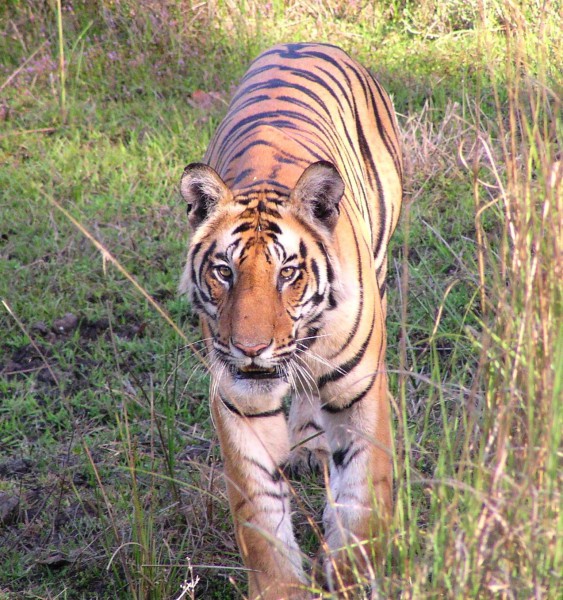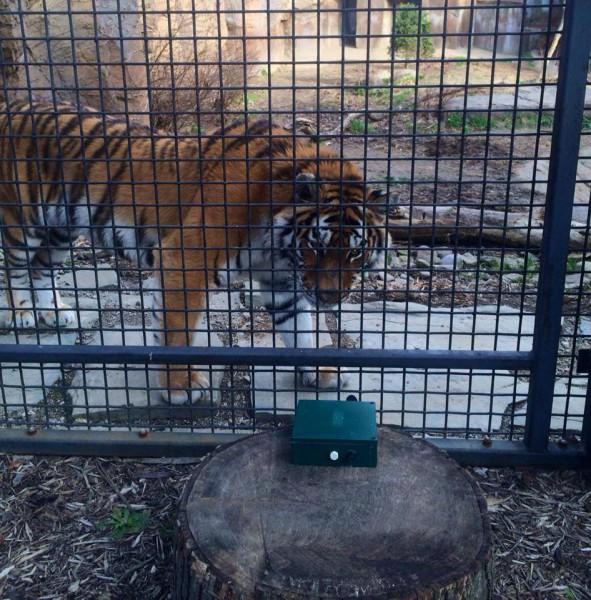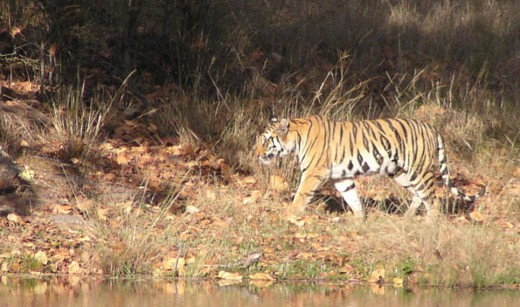- Wildlife acoustics help field researchers estimate population size and presence of a range of animal species.
- The Prusten Project uses automated recording units to identify tigers, which may help in estimating population sizes in dense forest landscapes and pinpointing core management zones.
- Understanding population dynamics of wild tigers can help direct the flow of resources (e.g. funds and rangers) to specific core areas to combat poaching attempts and to protect these areas from negative human impacts.
Wildlife acoustics have been used for over twenty years by field researchers to estimate population size and occurrence for various species, particularly birds and marine mammals. Wildlife acoustics research deploys units that record the sounds of the surrounding environment and store the sound data until researchers can upload them to a software program for analysis and visual display.
In the woodlands of Ontario, Canada, Stephen Holmes and his colleagues (2014) at the Canadian Forest Service compared automated sound recording and analysis to the traditional ‘point-count’ method frequently used to survey bird species. They aim to improve upon the ‘point-count’ method, which relies on trained field personnel and is thus subject to human error and variability in results.
The team set out a receiver at one point-count station per woodlot to listen for bird calls at a series of times around local sunrise and sunset. In this study, the researchers counted three endangered bird species: Acadian flycatcher (Empidonax virescens), Prothonotary warbler (Protonotaria citrea), and the Cerulean warbler (Setophaga cerulea). They compared the sound data of each species to a database of sound files. Once an experienced observer confirmed the accuracy of each candidate vocalization, the team generated a ratio of confirmed to candidate vocalizations as a measure of accuracy.

They found several benefits to using the system. First, the continuous recording capacity of the automated sound recording and analysis system enables more survey data to be collected. Second, the reduced need for human labor in the field decreases both the likelihood of human error and the funding needed to hire and train specialist field personnel. Third, sound recordings provide a permanent record of calls to enable playbacks and further analysis later on. Overall, the automated analysis of the sound recordings detected local, at-risk avian species as competently as trained field personnel for two out of the three avian species and with less hassle.
While acoustic monitoring has helped researchers confirm the presence and estimate numbers of bird, reptile, and aquatic mammal species, researchers appear to have only recently implemented this technology for large terrestrial mammal research.

Identifying tigers through vocalizations
The Prusten Project studies social vocalizations of tigers to determine whether the calls vary by age, sex, or individual. Such differences could assist efforts to survey populations of tigers (Panthera tigris), one of the most endangered big cats, with minimal disruption.
Tigers have been extirpated from the majority of their historic range over many generations; however, in the last decade, their disappearance has accelerated. Wild tiger populations have declined by 50% in the last decade, from roughly 7,800 to 3,200 individuals, due in large part to poaching of tigers and their prey, an expanding human footprint (i.e. habitat fragmentation, encroachment and destruction), and illegal trafficking of tiger body parts.
In an email correspondence with Wildtech-Mongabay, Courtney Dunn, Founder and Director of The Prusten Project, described the details, current status, next steps, and hopes of the project.
The Project records tiger vocalizations using automatic recording units (ARUs), recording devices with a microphone and amplifier that can be programmed to record at specific intervals. They currently deploy the Songmeter SM2 Platform ARU, created by Wildlife Acoustics, which automatically records the tigers based on the team’s pre-determined schedule. The units can sit at a study site for weeks at a time, collecting vocalizations and storing the sound data on memory cards.

The team has started with the ARU data from tigers in Association of Zoos and Aquariums (AZA) accredited facilities in the United States. The next step is to deploy the ARUs in the wild, with a pilot study underway in Sumatra to learn how the units function in dense forest. When more funding is available, Dunn plans to conduct the study in other tiger range countries, including India and Nepal.
Currently, the research team manually collects the memory cards, and offloads the data into Cloud storage. They hope to eventually have the recorders upload to Cloud storage without having to retrieve the cards from the field. Once the information is uploaded to the Cloud, they use Cornell University’s Raven Pro- Sound analysis software to search for tiger vocalizations among the recorded sound data.
The analysis software examines the tiger recordings to highlight ‘acoustic fingerprints’ (i.e. differences in the sound waves they produce) of individual tigers. The team processes the acoustic signals and aims to distinguish the vocalizations by individual, subspecies, and gender, to help identify and approximate the number of individual tigers in a given area. With this information, rangers and law enforcement can better locate the core areas (i.e. areas with highest concentration of tigers) where they can focus their protection and patrolling resources.
Tigers produce a wide range of vocalizations, some of which can be detected several kilometers away. The SMX-II weatherproof acoustic microphones attached to the units pick up vocalizations both within and out of human hearing range, as well as detect other fauna that communicate through vocalizations. Dunn says that the microphones could even pick up sounds of poaching activity (e.g. intruders moving through the forest, gunshots or chainsaws used for illegal logging activity).
The Prusten Project encourages public participation in their effort, to spread interest and concern for conservation issues. Volunteers can help analyze the vocalizations after completing a simple, free training session; they can also raise funds or interest via social media.

Tiger vocalization analysis using this hardware and software could be a more effective method of collecting mammal population census in visibility-limited environments, such as dense jungle. In the words of Courtney Dunn, the hope of The Prusten Project is to “revolutionize how [Asian] forest ecosystems are studied and protected”. The ability of law enforcement to know where tigers concentrate will help forces defend against poachers.
While focusing on highly used core areas is critical for efficient law enforcement, protecting the entire range of tiger habitat —including critical corridors—is necessary to preserve the species as a whole. While ARUs may help scientists identify critical zones of high tiger density, they are just one piece of a larger whole that makes up tiger conservation.
For questions or comments on using acoustic software or deploying ARUs in the field, please visit our animal monitoring forum and start or join a discussion.
Citations
Holmes, Stephen B., Kenneth A. McIlwrick, and Lisa A. Venier. “Using Automated Sound Recording and Analysis to Detect Bird Species-at-Risk in Southwestern Ontario Woodlands.” Wildlife Society Bulletin (2013): n. pag. Wildlife Acoustics. Web. Here’s a PDF.
Shaffer, Jessica W., David Moretti, Susan Jarvis, Peter Tyack, and Mark Johnson. “Effective Beam Pattern of the Blainville’s Beaked Whale (Mesoplodon Densirostris) and Implications for Passive Acoustic Monitoring.” Acoustical Society (2013): 1770-784.